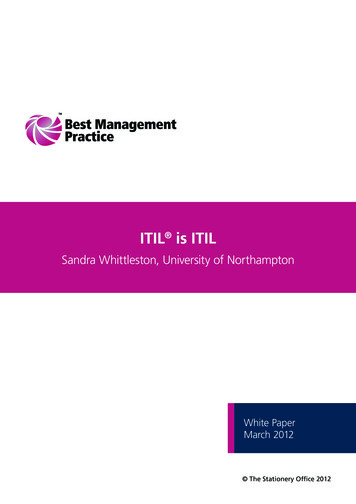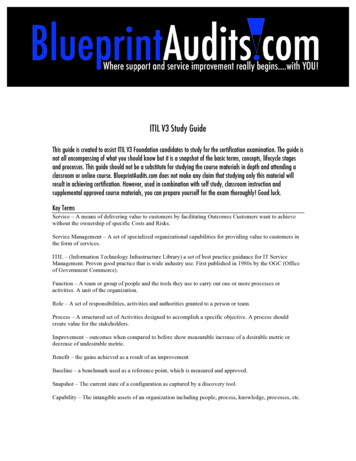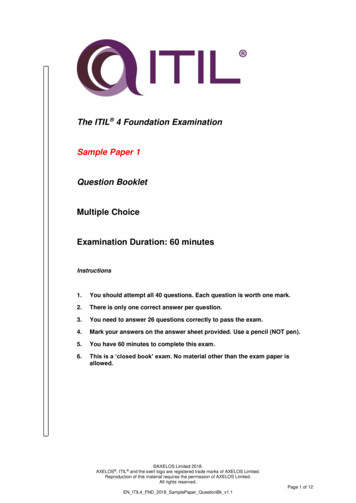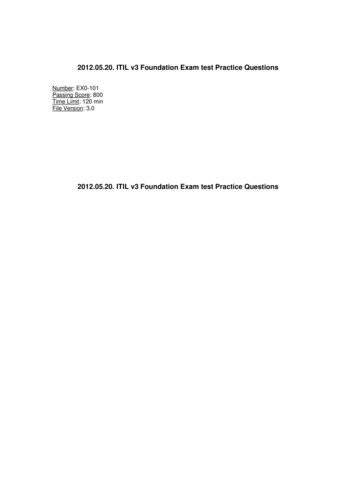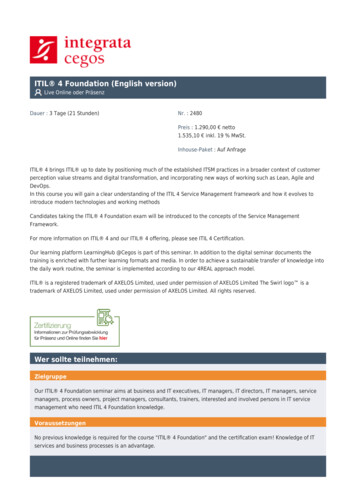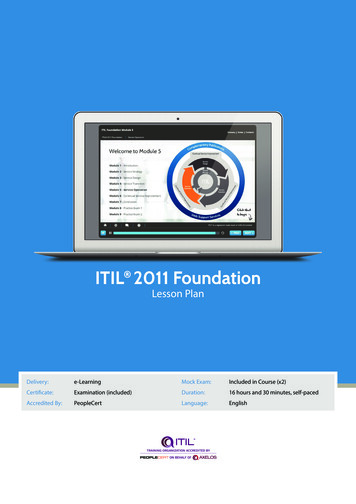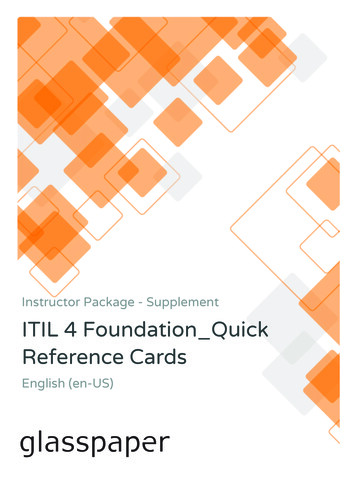
Transcription
Instructor Package - SupplementITIL 4 Foundation QuickReference CardsEnglish (en-US)
Four Dimensions of Service Management SystemThe four dimensions of service management ensures a holistic approachto service management and enables effective and efficient facilitationof value of customers and other stakeholders. These four dimensionsrepresent perspectives which are relevant to the whole SVS and to specificproducts and services. Organizations should ensure that there is a balanceof focus between each dimension.Copyright AXELOS Limited 2019. All rights reserved.ITIL is a registered trade mark of AXELOS Limited, used under permission of AXELOS Limited. All rights reserved.Based onAXELOS contentITIL Foundation(ITIL to4 brendanedition), 2019material.issuedReproducedunder licence fromAXELOSLimited.rights reserved.Traininglicensedmartin,on 06-03-2019,edition2019by AllGlasspaperLearningA/S
Four Dimensions of Service Management System 12Organizations andPeopleInformation andTechnologyFormal organizational structures and culture.Roles, responsibilities, and systems of authority andcommunication.Skills and competencies of teams or individualmembers, management and leadership styles. Information, knowledge, and technologies necessaryfor service management.Relationships between different components of theSVS, such as the inputs and outputs of activities andpractices.Information created, managed, and used in the course ofservice provision and consumption, and the technologiesthat support and enable a particular service.Exchange of information between different servicesand service components.34Partners andSuppliersValue Streams andProcessesRelationships with other organizations that areinvolved in the design, development, deployment,delivery, support, and/or continual improvement ofservices.Contacts and other agreements between theorganization and its partners or suppliers. Working of various parts of the organization in anintegrated and coordinated way to enable valuecreation through products and services.Activities, workflows, controls, and procedures neededto achieve agreed objectives.Identification and understanding of the various valuestreams and structuring the organization’s service andproduct portfolios around value streams allows.Identification and removal of any barriers to workflowand non-value-add activities, that is waste.Copyright AXELOS Limited 2019. All rights reserved.ITIL is a registered trade mark of AXELOS Limited, used under permission of AXELOS Limited. All rights reserved.Based onAXELOS contentITIL Foundation(ITIL to4 brendanedition), 2019material.issuedReproducedunder licence fromAXELOSLimited.rights reserved.Traininglicensedmartin,on 06-03-2019,edition2019by AllGlasspaperLearningA/S
The ITIL Guiding PrinciplesAre recommendations toguide an organization inall situations.Support successful actionsand good decisions of alltypes and at all levels.THE SEVENITIL GUIDINGPRINCIPLESEnsure a commonunderstanding andapproach to servicemanagement acrossthe organization.Are universally applicableto almost any initiative andto relationships with allstakeholder groups.Organizations should consider the relevance of each principle and how they can beapplied together. Not all principles will be critical in every situation; the principlesshould be reviewed and applied based on their relevance in different situations.Copyright AXELOS Limited 2019. All rights reserved.ITIL is a registered trade mark of AXELOS Limited, used under permission of AXELOS Limited. All rights reserved.Based onAXELOS contentITIL Foundation(ITIL to4 brendanedition), 2019material.issuedReproducedunder licence fromAXELOSLimited.rights reserved.Traininglicensedmartin,on 06-03-2019,edition2019by AllGlasspaperLearningA/S
The ITIL Guiding PrinciplesFocus on ValueMap every action, directlyor indirectly, to value for thestakeholders. Encompasses allperspectives, including theexperience of customersand users.Start Where You AreAlways consider what isalready available to beleveraged. Current stateshould be investigatedand observed directly toensure it is understood.Progress iterativelywith feedbackDo not attempt to do everythingat once. Use smaller, manageableiterations to execute and completein a timely manner and maintainfocus on each effort. Use feedbackbefore, throughout and after toensure actions are focused.Collaborate andpromote visibilityThink and workholisticallyNo service, or element used toprovide a service, stands alone.The outcomes will suffer unlessthe organization works on theservice as a whole, not just onits parts.Keep it simple andpracticalEliminate that which providesno value or produces no usefuloutcome. In a process orprocedure, use the minimumnumber of steps necessary toaccomplish the objective(s).Use outcome-based thinkingfor practical solutions andresults.Optimize andautomateResources, including humanresources (HR) and technology,should be used to their besteffect. Human interventionshould only happen whereit really contributes value.Work together across boundariesto have greater buy-in and betterlikelihood of long-term success.Work should be visible, hiddenagendas avoided and informationshared to the greatestdegree possible.Copyright AXELOS Limited 2019. All rights reserved.ITIL is a registered trade mark of AXELOS Limited, used under permission of AXELOS Limited. All rights reserved.Based onAXELOS contentITIL Foundation(ITIL to4 brendanedition), 2019material.issuedReproducedunder licence fromAXELOSLimited.rights reserved.Traininglicensedmartin,on 06-03-2019,edition2019by AllGlasspaperLearningA/S
The ITIL Service Value ChainValue created for theorganization, its customersand other stakeholders.Opportunity and demandfeeding into the SVS from bothinternal and external sources.The service value chain is a set of interconnected activities that an organization performsto deliver a product or service to its customers and to facilitate value realization.The ITIL service value chain is a flexible operating model that: Defines six activities that can be combined in various ways. Can be adapted to multiple approaches, such as DevOps and Centralized IT. Is enhanced by the ITIL practices; each ITIL practice supports multiple service value chainactivities.Copyright AXELOS Limited 2019. All rights reserved.ITIL is a registered trade mark of AXELOS Limited, used under permission of AXELOS Limited. All rights reserved.Based onAXELOS contentITIL Foundation(ITIL to4 brendanedition), 2019material.issuedReproducedunder licence fromAXELOSLimited.rights reserved.Traininglicensedmartin,on 06-03-2019,edition2019by AllGlasspaperLearningA/S
The ITIL Service Value ChainDeliver and supportEnsuring the delivery and supportfor services according to agreedspecifications.Acquire/BuildEnsuring that the service components areavailable when and where they are neededand meet the agreed specifications.Design and transitionEnsuring that the servicescontinually meet expectations forquality, costs, and time-to-market.EngageProviding engagement and understandingof stakeholder needs, transparency, andgood relationships.ImproveEnsuring continual improvementacross all value chain activity andthe four dimensions of servicemanagement.PlanEnabling the shared understanding of thevision, status, and direction for all services.Six Activities ofService Value ChainIn order to convert inputs into outputs, the value chain activities use different combinationsof ITIL practices.In order to carry out a certain task or respond to particular scenario, service value streamsare created. Service value streams are specific combinations of activities and practices,designed for a particular scenario.Copyright AXELOS Limited 2019. All rights reserved.ITIL is a registered trade mark of AXELOS Limited, used under permission of AXELOS Limited. All rights reserved.Based onAXELOS contentITIL Foundation(ITIL to4 brendanedition), 2019material.issuedReproducedunder licence fromAXELOSLimited.rights reserved.Traininglicensedmartin,on 06-03-2019,edition2019by AllGlasspaperLearningA/S
The ITIL Practices: PurposeAn ITIL practice is a set of organizational resources designed for performing a work or fulfillingan objective. The practices enhance the flexibility of the service value chain. Each ITIL practicesupports multiple service value chain activities, providing a comprehensive and adaptabletoolset for ITSM practitioners.1General Management PracticesContinual ImprovementAligning the organization’s practices and services with changing business needs through the ongoingidentification and improvement of services, service components, practices, or any other elementinvolved in management of products and services.Information Security ManagementProtecting information needed by the organization; ensuring confidentiality, integrity, availability,authentication, and non-repudiation.Relationship ManagementEstablishing and fostering the links between the organization and its stakeholders at strategic andtactical levels. Includes identification, analysis, monitoring, and continual improvement of relationshipswith and between stakeholders.Supplier ManagementManaging suppliers and their performance to support the seamless provision of quality products andservices. Includes creating collaborative relationships with key suppliers to uncover and realize new valueand reduce the risk of failure.2Service Management PracticesIT Asset ManagementPlanning and management of IT assets to maximize value, control costs, manage risks, support decisionmaking about purchase, re-use, retirement of assets, and meet regulatory and contractual requirements.Monitoring and Event ManagementObserving services and service components and recording and reporting changes of state identified as events.Includes identifying and prioritizing infrastructure, services, business processes, and information securityevents and establishing the appropriate response to those events.Copyright AXELOS Limited 2019. All rights reserved.ITIL is a registered trade mark of AXELOS Limited, used under permission of AXELOS Limited. All rights reserved.Based onAXELOS contentITIL Foundation(ITIL to4 brendanedition), 2019material.issuedReproducedunder licence fromAXELOSLimited.rights reserved.Traininglicensedmartin,on 06-03-2019,edition2019by AllGlasspaperLearningA/S
The ITIL Practices: PurposeRelease ManagementMaking new and changed services and features available for use.Service Configuration ManagementEnsuring accurate and reliable information about the configuration of services, and the configurationitems that support them.Change ControlMaximizing the number of successful IT changes by ensuring that risks have been properly assessed,authorizing changes to proceed, and managing the change schedule.Incident ManagementMinimizing the negative impact of incidents by restoring normal service operation as quickly as possible.Problem ManagementReducing the likelihood and impact of incidents by identifying actual and potential causes of incidentsand managing workarounds and known errors.Service DeskCapturing the demand for incident resolution and service requests. Service Desk is a point ofcommunication for the service provider with all its users.Service Level ManagementSetting clear business-based targets for service performance, so that delivery can be assessed, monitoredand managed against these targets.Service Request ManagementHandling all predefined, user-initiated service requests in an effective and user-friendly manner.Technical Management Practices3Deployment ManagementMoving new or changed hardware, software, documentation, processes, or any other component tolive environments. Deployment management may also be involved in deploying components to otherenvironments for testing or staging.Copyright AXELOS Limited 2019. All rights reserved.ITIL is a registered trade mark of AXELOS Limited, used under permission of AXELOS Limited. All rights reserved.Based onAXELOS contentITIL Foundation(ITIL to4 brendanedition), 2019material.issuedReproducedunder licence fromAXELOSLimited.rights reserved.Traininglicensedmartin,on 06-03-2019,edition2019by AllGlasspaperLearningA/S
The Seven Core ITIL PracticesContinual ImprovementThe scope of the continual improvement practice includes the development of improvement-related methods andtechniques and the propagation of a continual improvement culture across the organization.Key activities of the continual practice include: Encourage continual improvement across theorganizationSecure time and budget for continual improvementIdentify and log improvement opportunitiesAssess and prioritize improvement opportunities Develop business cases for improvement actionPlan and implement improvementsMeasure and evaluate improvement resultsCoordinate improvement activities across theorganization.Continual improvement is the responsibility of everyone in the organization and the partners and suppliers related toorganization.Approaches to continual improvement can be found in many places, including Lean and Agile methods.Change Control The scope of change control typically includes all IT infrastructure, applications, documentation, processes, supplierrelationships, and all that might directly or indirectly impact a product or service. Change control must balance the need to make beneficial changes that deliver additional value with the need toprotect customers and users from adverse effect of change. Three types of change that are each managed in different ways are standard changes, normal changes, andemergency changes. For change control to be effective and efficient, it is essential that the correct change authority is assigned to eachtype of change. The change schedule helps to plan changes, assist in communication, avoid conflicts, and assign resources.Incident ManagementThe key activities of incident management include: Logging and managing the incidentsAgreeing, documenting and communicating the target resolution timesPrioritizing the incidents based on agreed classificationDiagnosing, escalating, and resolving the incidentOrganizations should design the incident management practice by: Appropriately managing and allocating resources to different types of incidentsStoring information about incidents in incident recordsProviding good-quality updates on incidentsIncidents may be diagnosed and resolved by people in many different groups, depending on the complexity of the issueor the incident type.Copyright AXELOS Limited 2019. All rights reserved.ITIL is a registered trade mark of AXELOS Limited, used under permission of AXELOS Limited. All rights reserved.Based onAXELOS contentITIL Foundation(ITIL to4 brendanedition), 2019material.issuedReproducedunder licence fromAXELOSLimited.rights reserved.Traininglicensedmartin,on 06-03-2019,edition2019by AllGlasspaperLearningA/S
The Seven Core ITIL PracticesProblem ManagementProblem management involves three distinct phases: problem identification, problem control, and error control.Problem IdentificationIdentifying and logging problems. Perform trend analysis of incident records.Detect duplicate and recurring issues. Identify a risk that an incident could recur.Analyze information received from suppliers, partnersand internal software developers.Problem ControlAnalyzing problems and documenting workarounds and known errors. Problems are prioritized based on the risk that they pose, and are managed as risks based on their potential impactand probability.When a problem cannot be resolved, a workaround needs to be found and documented. Workarounds are documentedin problem records.Error ControlManaging known errors. Error control involves identifying potential permanent solutions. These permanent solutions may involve a change request.Service Request ManagementHandling all pre-defined, user-initiated service requests in an effective and comprehensible manner. Service requests are pre-defined and pre-agreed, they should be formalized with a clear, standard procedure forinitiation, approval, fulfilment, and management. The fulfilment of service requests may include changes to services or their components. These changes usually fallunder category of standard changes. Service requests form a normal part of service delivery, and not a failure/degradation of service.Service Desk Service desk acts as the entry point/single point of contact for the IT or service organization. Service desk should have practical understanding of the wider organization, its business processes, and users. Service desk works in close collaboration with the support and development teams to present and deliver a ‘joinedup’ approach to users and customers. A service desk may work at a single or centralized location or it may act as a virtual desk that enables agents to workfrom different geographical locations.Service Level Management The service level management practice involves the definition, documentation, and active management of servicelevels and provide end to end visibility of the organization’s services. Service Level Agreements (SLAs) is a tool used to agree on the service between the provider and customer. SLAs mustrelate to a defined service in the service catalogue and should relate to defined outcomes.Copyright AXELOS Limited 2019. All rights reserved.ITIL is a registered trade mark of AXELOS Limited, used under permission of AXELOS Limited. All rights reserved.Based onAXELOS contentITIL Foundation(ITIL to4 brendanedition), 2019material.issuedReproducedunder licence fromAXELOSLimited.rights reserved.Traininglicensedmartin,on 06-03-2019,edition2019by AllGlasspaperLearningA/S
Published y
The ITIL service value chain is a flexible operating model that: De !nes six activities that can be combined in various ways. Can be adapted to multiple approaches, such as DevOps and Centralized IT. Is enhanced by the ITIL practices; each ITIL practice supports multip


